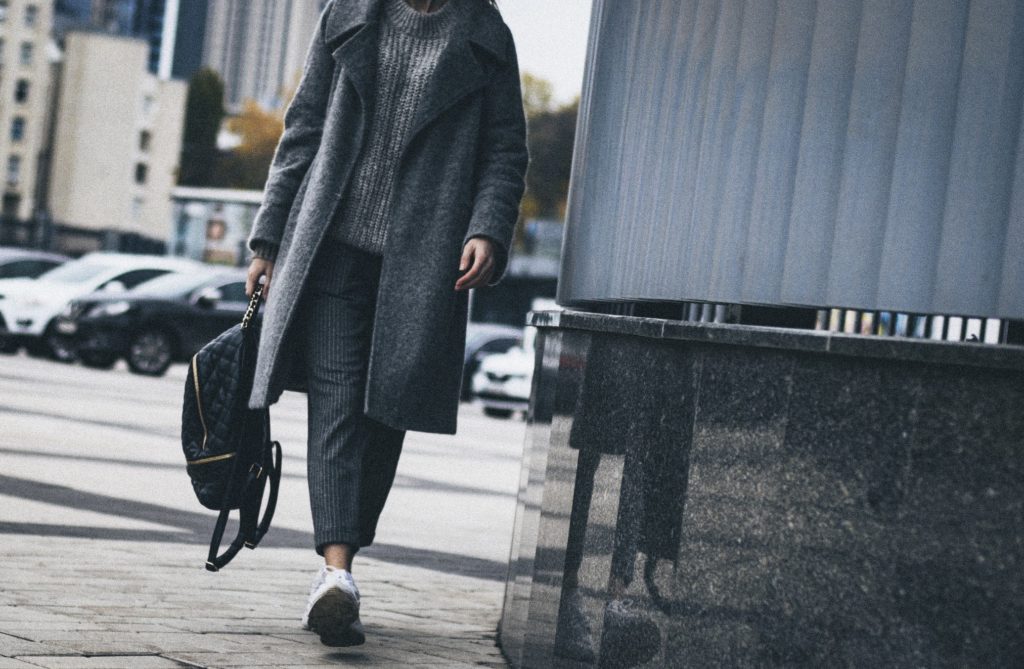How does a modern women dress in order to convey authority and competence at work? You can spend a lot of time and money shopping and still not get it right, and who wants to do that? So how can you know what’s worth investing in and what’s not? And is there a formula for this? Why yes, dear reader, there is.
We have a few boss women here on our staff, and we surveyed them and a bunch more, and reflected on our own experiences in board rooms and corporate settings.
Here are 12 simple rules to consider when you’re dressing to impress as a professional.
1. Have a go-to color palette. One of our C-Suite female friends sticks to blue, grey and black – that’s a brilliant choice, as those colors look good on everyone, and they convey authority and trustworthiness (according to studies of the impact of various colors on our perceptions). They also work in all seasons and across any industry. If blue is part of your palette, you can easily incorporate dark navy jeans into the mix, which is part of the standard “uniform” in some workplaces. Some keep it even simpler: just black and white, all day every day. We’d also suggest considering ivory, red, grey and black. We got all the way through graduate school on a pauper’s budget by adhering to that palette (if everything in your wardrobe is one of those four colors, you’d be amazed how many cool combinations you can come up with). If you’re on a limited budget, and want to focus on investment pieces, having a strict color palette will serve you extremely well.
2. Have a “uniform.” It doesn’t have to be Steve Jobs black, although it could be. It doesn’t have to be precisely the same thing every single day. Although it could be. It just needs to be a formula that works for you and that you can follow without thinking too much. One that suits you, makes you feel confident, and is comfortable enough for a 12-hour+ workday. For example: a print knit dress. A statement blouse and a simple skirt. Or a statement skirt and a solid-color fitted knit sweater. Or dark pants or jeans with a cool top or jacket. You can riff on your chosen theme in all kinds of ways, including the shoes you wear, and no one will know. They’ll think you look great every day, and they’ll wonder how you’re doing it. A go-to uniform makes it a lot easier to pack for a business trip, and also makes your morning routine a lot less frantic.

3. Pay attention to your accessories. The appearance of your shoes and your bag need to be impeccable. These are definitely worth investing in. Long ago, when we were baby consultants, we were told by one of the first women partners at McKinsey & Company that if your shoes are scuffed, or the heels have “bites” taken out of them from subway grates or sidewalks, it’s a sign that you’re not serious and detail-oriented. “You think people don’t notice, but they do,” she proclaimed. Your accessories don’t have to be crazy-expensive. But your shoes need to be polished and in good shape, and your bag can’t be in visible need of cleaning or repair. Most of the time, hard-soled closed-toe shoes are the way to go: ballet flats, boots, booties, Mary Janes or pumps. Boss women could wear flip-flops to work – but most don’t. Sneakers are your call – we save ours for our personal time, but plenty of male tech bosses live in them 24/7, so why not you?
4. Have one great coat. If you live in a cold-weather location, the first impression that you make on clients, potential employers and others in your professional sphere will be based in large part on your outerwear. A great black coat will carry you for a decade or more. Even in warm climes, you’ll need a trench or a raincoat. A high-quality one will last for years, and it’s totally worth investing in.

5. Know when you need to wear a jacket – not a soft shoulder. Plenty of tough women wear soft silhouettes – a draped top, a sweater or a shrug. Some never wear a strong-shouldered jacket, even in the most formal situations. In our experience, there are times when a jacket is a must. You might be in a casual workplace – a sharply tailored jacket will telegraph authority, even when paired with jeans. If you’re surrounded by bankers, lawyers, or other big-shouldered types, or if you’re calling on someone in the government or in the military, you need to show a level of gravitas and respect that demands a tailored jacket, if not a full matching suit. Those occasions are rare, but don’t blow them when they arrive. A related suggestion: if you’re unsure of the level of formality for a meeting or other professional gathering, err on the side of being “too formal.” You can always toss your jacket, and roll up your sleeves, and be instantly more casual. It’s much harder to do the opposite.
6. Focus on your upper half. Most business meetings and meals still happen around tables, and how you look when seated should be a priority, since 80% of the time, that’s what people are going to see. A crisp shirt can convey competence. A jacket instantly elevates your level of professionalism. Before you pack an item for a big meeting, or choose one on a big day, stress test it: put in on, and sit down in front of a mirror. If it’s tugging, pulling, exposing too much cleavage, or in any other way not showing up properly, ditch it and find one that works. We all have outfits in our closets that look businesslike when we’re standing up, but not so much when we’re seated.

7. Match your heel height to the height of the people with power around you. We know that everyone won’t agree with this one, but we think it’s true: we happen to love high heels, and we strongly recommend them for anyone working around a bunch of people whose physical stature is significantly taller than theirs. Of course there are exceptions, and it’s clearly your call. In our experience, you need to get as close to eye level as possible if you want to be able to communicate your point of view as effectively as possible. The corollary to this, though, is that you should never wear a heel so high that you can’t stride purposefully alongside the rest of the group.

8. When it comes to hair, don’t let it get distracting. You can opt for highly feminine long and lush locks, or short-simple-and-chic. You can go for natural curls or sleek blow-dryed straight. That’s your call, and happily we can now point to successful women who’ve opted for all the above. Whatever style you choose, just be sure that your mane looks healthy (and clean). Fix your ‘do before work and once you’re in the office, forget about it.
9. Ditto your makeup. Not too much, but not too little. It’s worth the investment to learn how to apply makeup – you can schedule a personal 1:1 session with an expert at Sephora for practically nothing. Many department stores are upping their beauty game, too, and most of the consultations are free. Do this once year or so, and you’ll be you out the door every morning in short order.

10. No wardrobe distractions. That means not showing too much skin, no VPL, no sheer or see-through tops, and no distracting jewelry. You can save all of that for your free time (or not). Think Wakanda warrior, not Wonder Woman (we love her, but seriously she needs more coverage when she’s out saving the world – a super hero should never be the one wearing the least amount of clothing in the room). Look at yourself in a mirror before you leave for work (or get your roommate/significant other/spouse to give you the once-over) and be sure that you’re pulled together from both the front and rear view.
11. Glasses are cool, and might even be a plus. Just make your specs interesting, and you might be pleasantly surprised at how much conversation they’ll spark (and how much authority they can exude).

12. Manicures are mandatory – your nails need to be well-groomed. We’ve been having an interesting conversation about nail color. We opt for neutrals when we’re in work mode, but members of our community have rightly pointed out that a somber black suit can use a pop of color, and nail polish can provide it. All good.
That’s it! Not so bad, right? We hope these ideas and the discussion they might help generate will help get you to where you really want to be a bit faster. Game on.
Come and join our community! For a weekly round-up of insider ideas and information on the world of luxury, sign up for our Dandelion Chandelier Sunday Read here. And see luxury in a new light.







